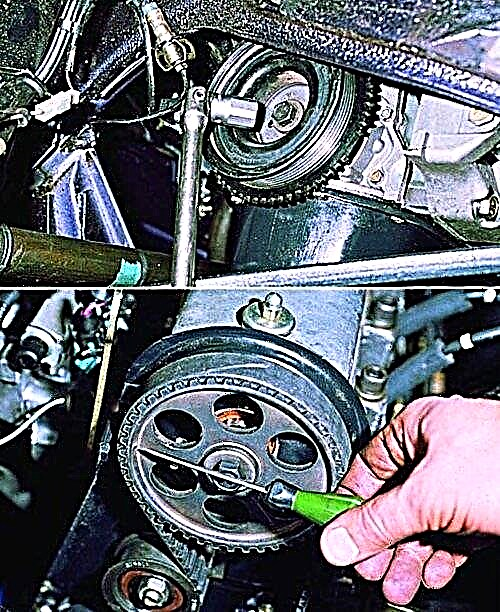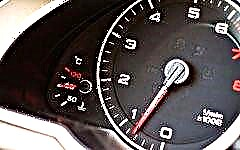

The content of the article:
- The importance of quality spark plugs
- Ignition system device
- Signs of malfunctioning spark plugs
- What do faulty candles look like?
- Initial diagnostics of spark plugs
- The consequences of using defective spark plugs
Almost all modern technology, from cars to ATVs, has an internal combustion engine. The main component of the engine that causes ignition are spark plugs. At the input, they are powered by high-voltage electricity, creating a "starting" spark at the output.
The importance of quality spark plugs

The resulting spark in the combustion chamber "ignites" the fuel-air mixture, starting a workflow that allows the engine to fully function. Due to spark plugs, the power unit comes to life, without them remaining a useless piece of metal.
The slightest defect in the spark plugs can adversely affect the performance of the engine, up to and including its failure. Therefore, if you suspect even minimal problems with candles, it is necessary to eliminate them without waiting for fatal consequences.
The serviceability of a small but important element must be checked at the time of the scheduled technical inspection, and replacement should be carried out according to the manufacturer's defined regulations.
At the moment of failure of a part, there is a jump in the load on the ignition coil, quickly ending in its breakdown. At the same time, the price of a spark plug is disproportionately small compared to the price tag for a coil. Driving with the engine, in which the spark plugs are faulty, is characterized by instability at idle and increased driver nervousness.
A well-oiled power unit runs smoothly and smoothly at 1000 rpm. Defective candles provoke jumps in the tachometer indicators, at the same time the engine can vibrate or emit an unpleasant grinding. Therefore, to determine the cause of the unstable operation of the engine, sinning on the ignition system, even a person who is far from automobile "iron" can do it.
Ignition system device

For many years, since the invention of the internal combustion engine, fundamentally no innovations in the structure and functionality of the candles have been introduced. The main task was and remains the conversion of electrical energy with the creation of a high-voltage arc, leading to the ignition of the fuel mixture.
The combustion chamber, where the "revitalization" of the engine takes place, includes:
- Ceramic insulator. It provides a steady and uninterrupted spark formation.
- Metal casing that allows the structure to be neatly installed in the engine.
- Electrodes that supply and convert electrical current into an arc.
- A contact head with a threaded connection.
The "heart" of the ignition system is two electrodes. The current from the generator flows through high voltage wires from the head directly to the candles. The technological process over the years of the existence of the internal combustion engine remains unchanged.
Signs of malfunctioning spark plugs

In the event of incorrect operation of the spark plugs, the power unit starts malfunction... It does not perform the necessary functions, and to resume its operability, urgent diagnostics and the help of specialists are required:
- Visible, severe difficulty starting the engine. This is an unconditional signal to the owner to check engine errors and replace the spark plugs.
- The behavior of the engine changes. He troit, twitches, the car loses power, the power drops.
- Problems with faulty spark plugs lead to a sharp increase in gas mileage. The ignition does not work constantly, skipping periods. As a result, the mixture does not fully burn out. Exhaust gas analysis shows a high proportion of CO.
- No matter how much pressure is applied to the gas pedal, the engine fails to pick up the required speed, and the work goes on with low power.
By responding early to signs of possible spark plug malfunction, catastrophic engine problems can be avoided in the future.
Identifying spark plug faults
The problem is visually determined by the "naked eye" even by a person far from the car. The first and defining indicator of spark plug malfunction is the uneven operation of the car - it constantly stalls.
The malfunction prevents the gasoline-air mixture from igniting inside the cylinder. Instead of burning, the fuel rushes into the catalyst. You can smell this defect with your nose - the aroma of gasoline is very sensitive.
Gasoline engines must maintain the temperature inside the cylinders of the order of 400-500 degrees Celsius for an efficient fuel combustion process. Only after reaching the "critical" temperature, the mixture will ignite without any problems, completely burning.
High temperature conditions negatively affect the performance of the spark plugs. All old parts are more or less layered.
Gradually, the electrodes become overgrown with deposits and build-ups that can have a direct effect on the candles, deteriorating the quality of the spark. A normal, efficient electrode always has a uniform color and shape, and no "artifacts" should be present on it.
Clean parts without traces of combustion on the electrodes indicate the health of the candles, the motor must work flawlessly.
Spark plug malfunction symptoms
Car owners should start to worry if certain signs and symptoms:
- The car "freezes" when the accelerator pedal is depressed "to the floor", without increasing or even losing power.
- Fuel consumption increases excessively.
- The engine fault icon illuminates on the control panel.
- Starting the engine is difficult during the cold season.
- The vehicle is unstable when idling.
- The engine starts after a long period of time with the starter running or does not start at all.
- The car suddenly stalls.
- Vibration of the power unit, tripping are detected.
Accurate diagnosis of the problem involves the need to unscrew the candles. Before doing this, the engine must be thoroughly warmed up. If the situation allows, it is advisable to drive at least 250 km by car. Then the result of a visual inspection will give an almost one hundred percent verification guarantee.
A removed spark plug should be carefully inspected for any damage. It is especially important to examine the spark plug tip in contact with the cylinder.
An excellent candle that has not lost its working properties may have a slight brownish or gray-brownish color of deposits. Candles and electrode remain light gray.
The consistency of the shade means that the problem lies in something else, because the spark plugs are in good, working condition.
Dirty and damaged candles can cause numerous problems. In case of a problem with starting the engine, the check is always started from scratch - they check the performance of the candles. A satisfactory external condition is an indicator of how well the engine is performing.
Such a check should be carried out during regular maintenance of the car, as well as spontaneously - if there is a suspicion of engine malfunction.
What do defective candles look like?

Soot black coating
If a strong plaque is detected on the ground, electrode, candle body, you can confidently declare that the parts are defective. The fault lies with the illiterate preparation of the fuel mass.In its composition, the proportions of fuel and air are violated, excessive "depletion" or "oversaturation".
Such deposits can occur in a situation when the air filter is dirty and needs to be replaced, there are malfunctions in the injection system, the temperature sensors are "depressed", and the lambda probe fails. Often accompanied by a double fuel consumption and means the need for urgent replacement of the spark plug.
Oil drips

The surface is covered with an oil film. This means that the cylinders contain an excessive amount of grease. This happens when the oil is overflowing into the engine. The symptom indicates old, damaged from time to time and during operation, the piston rings and the pistons themselves, as well as valve guides.
For vehicles with a turbocharger, the presence of oil contamination indicates a compressor defect.
Slag, shiny deposits

They can be detected by visual inspection. They have a greenish or brownish-yellowish color, meaning that additives are actively used in the fuel or oil. It is also an indication that the engine is running on an excessively lean mixture or on gas.
Slag deposits from particles of fuels and lubricants
They can form due to the addition of additives to the oil. Today, many manufacturers have begun to use them to "improve" the properties of the lubricant. As a result, they become the cause of problems with the power unit and the failure of the entire ignition system.
If the deposits look like a layer of lime, this clearly confirms the presence of additives. The engine is at risk due to the accumulation of slag in the piston system.
Fused electrode

If the central electrode melts, the edges of the grounding element are carbonized, and the "body of the candle" suffers. The problem manifests itself during operation - the spark plug overheats due to a faulty ignition system.
The presence of metal particles near the electrode and signs of fusion confirms excessive overheating, leading to deformation of the valves and baking of the piston elements. This happens when there are additional deposits in the combustion chamber that can ignite spontaneously. The symptom indicates poor valve operation or poor quality fuel.
Increased wear of the electrode, unsuitability of the grounding element
These factors lead to damage to the candle material. The problem lies in the use of "diluted" gasoline containing many additives or the purchase of an "improved" oil due to additives for the car. Rapid wear can be associated with detonations, frequent overheating.
Damaged connector
The spark plug is worn out in the place where the spark occurs or in the area of contact with the high-voltage wire. The causes of the malfunction are an old, worn out wire connector or constant strong overheating.
Destruction of ceramics on the insulator
Any mechanical damage, even the smallest, to the ceramic layer means a damaged part. It is subject to unconditional replacement.
Initial diagnostics of spark plugs

Diagnostics of the spark plugs requires unscrewing them, while listening to how the power unit sounds. The rhythm and stability of the motor, the invariability of the sound is an indicator that the dismantled candle is not suitable for use, the engine "does not see" it.
Another check option advises to disconnect the wire from the spark plug, touch it to the cylinder block. There is always a spark in a good candle. If not, the candle must be replaced.
The defect can be "caught" by a signal from the ECU. Thus, the problem, in addition to the visual inspection process, can also be found with the help of the electronic control unit.
Consequences of using defective spark plugs

When using inoperative spark plugs, detonation occurs inside the cylinders, generating a strong shock wave. She, in turn, is a provocateur of the detonation of that part of the charge that did not work, remaining inside the cylinder. As a result, the motor loses power.
Serious overheating has a detrimental effect on the crankshaft, working pistons, connecting rods. Other parts are burned out, the protective oil coating of the cylinder is destroyed.
Time to change candles
For any car, it is useful to change the candles on a planned basis when going through a technical inspection. Manufacturers of standard plugs prescribe the necessary replacement after 15 thousand kilometers.
However, it all depends on the manufacturer and the type of candle. Experienced drivers recommend changing them after 20-30 thousand kilometers. Platinum parts last much longer, withstanding up to 100 thousand kilometers.
It is important to monitor the quality of the fuel so that carbon deposits do not accumulate on the spark plugs, and they do not break out prematurely earlier than stipulated by the regulations.
Conclusion
A faulty spark plug leads to incorrect engine operation, damage to its components, and in the end - to engine repair. Timely replacement avoids major problems with the power unit. Professional diagnostics of the engine and ignition system are available at most service centers.











